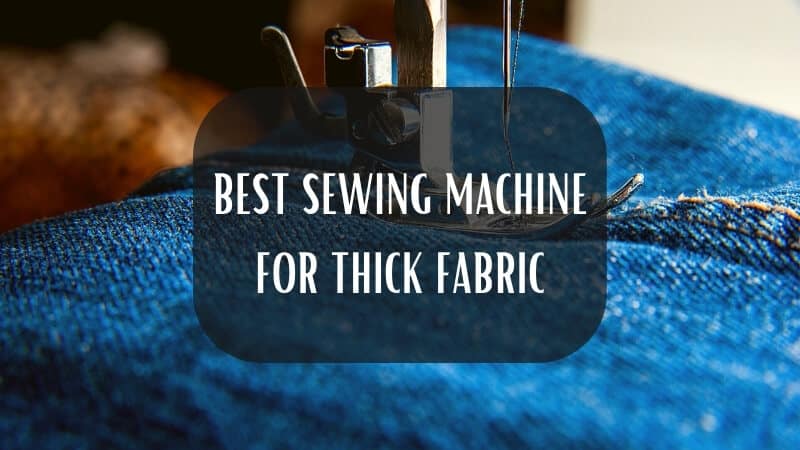5 Best Sewing Machine for Thick Fabric
What would you choose between a mechanical sewing machine and a computerized one?
Well, the answer circles around the purpose and the desired outcome. If you are a beginner and you prefer limited functionalities, then having a mechanical sewing machine will do the job.
But what if you want to make some complicated embroidery on thicker fabrics? In this case, you will need various sewing stitches available other than zig-zags and straight stitches.
And in order to get the best sewing machine for thick fabric that flexibly works for beginners, intermediates, and professionals, we have compiled the 5 finest sewing machines in today’s article!
Let’s have a look!
5 Best Sewing Machine for Thick Fabrics Reviewed
Throughout the assessment of different quilting machines for the various sewing projects, we have coined some crucial features that most of the consumers strive to have.
And focusing on those characteristics, we have finally come up with these 5 sewing machine review that offers seamless stitches, smooth fabric feeding, durable metal needle plate, and impeccable speed control.
Let’s wade through them one by one!
IMAGES | DESCRIPTION | RATING | PRICE |
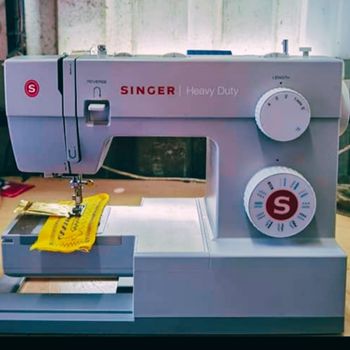 | 1. SINGER | Heavy Duty 4423 Sewing Machine
| ||
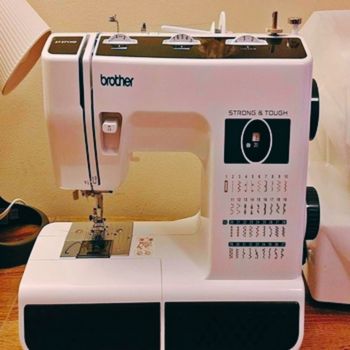 | 2. Brother ST371HD Sewing Machine
| ||
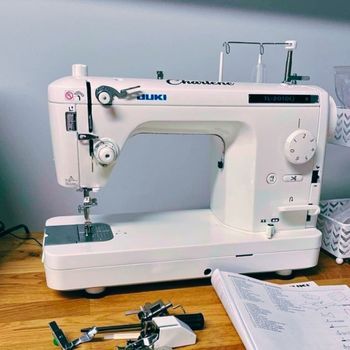 | 3. Juki TL-2010Q 1-Needle, Lockstitch, Portable Sewing Machine
|
1. SINGER | Heavy Duty 4423 Sewing Machine

Features
- Type: Mechanical
- Speed: 1100 Stitches Per Minute
- Built-in Stitches: 23
- Stitch Length x Stitch Width: 4 mm x 6 mm
- Noise Level: 71.4 dB
On top of the list, we have Singer’s heavy duty sewing machine with a seamless gray profile. It’s comprised of 23 built-in stitches so that you can accomplish complicated sewing projects.
Be it a basic stitch or decorative stitches, Singer 4423 sewing machine impressively takes care of it. Furthermore, if you are looking for buttonhole stitches for diverse home decor and crafting needs, then this heavy-duty machine will do the job. For example, this unit is also regarded as the best sewing machine for making wigs.
Now, you might assume that this tool is only for the expert, whereas a beginner can also operate it for sewing heavy fabrics if the basic tactics are followed.
Besides, this tool distributes 1 to 100 stitches per minute to enhance your productivity. Also, the innate speed control deters contingent sewing fumbles so that you no longer need to repeat or redo your stitches.
Here the best part of this stainless steel machine is the robust motor, which is relatively 60% strong than most of the top trending quilting machines.
Usually, the obsolete sewing machines fail to run through heavyweight fabrics such as denim and canvas. But the Singer facilitates exceptional piercing power for thicker fabrics. All credit goes to the strong motor.
Now, let’s talk about durability. As far as we have scrutinized and evaluated the customer’s feedback, we believe that the frames are made of heavy-duty metal as the company claims.
Also, this durable machine ensures delivering utmost stability; thus, you can submit your reliance on this tool for years. To conclude, you will get plenty of accessories that includes zipper foot, button sewing foot, heavy-duty needles, lint brush, clearance plate, auxiliary spool pin, bobbin, seam ripper, etc. At this rate, the singer sewing machine is undoubtedly a bang for the money!
PROS:
CONS:
2. Brother ST371HD Sewing Machine

Features
- Speed: 800 SPM
- Stitches Number: 37
- Stitch width: 7 mm
- Weight: 14.3 lbs
- Warranty: 25-years limited
One of the major problems of sewing machines is delicate needle plates that tend to break when ran through thick fabrics.
Here when you have the best brother sewing machine for thick fabrics, you don’t have to stress over weak needle plates or inconsistent buttonholes.
The strong metal needle plates include high-density needles so that it can withstand thicker fabric and resolves everyday sewing projects.
No matter you are a beginner or an expert, the straightforward use and an array of stitching techniques help you accomplish the job.
Speaking of various stitching styles, this affordable sewing machine offers 37 unique built-in stitches accompanying an auto-size buttonhole. Hence you get uniformed buttonholes with appropriate gaps.
Also, the multitude of different stitch lengths opens the room for numerous designs as well as improvement.
Now, if you feel intimidated by the huge number of stitches, you can watch the instructional DVD to decipher each method precisely. Now comes the drop-in bobbin that reduces the jamming tendency and holds the fabric so that you don’t make any mistakes. Also, it has an automatic built in needle threader for feeding the thread within the needle seamlessly.
Last but not least, it has a heavy-duty machine with 6 sewing feet, including a spring action zigzag foot and nonstick, blind stitch, zipper, buttonhole and buttonhole sewing feet.
Consequently, it enables holding the fabric flat when it’s fed through the machine. With the sewing speed of 800 stitches per minute and complete free-motion sewing facility, you barely make any mistake instead effortlessly end your task.
Well, this one costs less than the singer machine, yet the ingrained quality and efficiency are praiseworthy.
PROS:
CONS:
3. Juki TL-2010Q 1-Needle, Lockstitch, Portable Sewing Machine

Features
- Type: Mechanical
- Speed: 1500 stitches per minute
- Stitch length: 6mm
- Weight: 38lbs
- Warranty: 5 year-limited
If you are looking for portable sewing machines that don’t make any shrill noise, then Juki TL-2010 can be the right choice for you.
Its aluminum construction is built to last. No wonder Juki is a prominent brand that distributes sturdy and long-lasting sewing machines for thick fabrics. Be it denim or canvas, Juki TK-2010 effectively completes the sewing task. Also, the arm and sewing bed of this quilting machine are crafted with aluminum die-casting. Hence it works ideally in intense working sessions such as mending denim jeans or crafting one from scratch.
Besides the superior portability helps you to transport it from one place to another without taking up any extra hassle.
This sewing machine constructively operates large quilts, home decor, and other intricate sewing jobs effortlessly. On top of that, it’s made of innovative features as an industrial sub-tension system, LED indicator, variable speed control slider, etc., to ensure sewing in precision.
Also, you are going to have an extension table up to 23 inches that will help you administer large and heavy fabrics. Furthermore, it offers an exclusive trimming system operated by your foot in order to trim top and bobbin threads.
Here the foot controller and trim button incorporate advanced Juki industrial style. Thus, you get utmost control over the sewing speed as well as trimming.
However, if you are anxious about sewing buttons on this sewing machine, you don’t need to worry anymore. It has the zig-zag stitch engaged with a button sew-on foot, which places the button within a few minutes.
You can also monitor the tension level with its thread tension scale. Mainly this feature helps you balance the tension depending on the thread and material diversity.
Lastly, you have the automatic thread button that instantly lowers the presser foot, and when you pull the thread loop slowly from the back of the needle, it threads the needle without any eyestrain.
PROS:
CONS:
4. Janome Industrial-Grade Aluminum-Body HD1000 Black
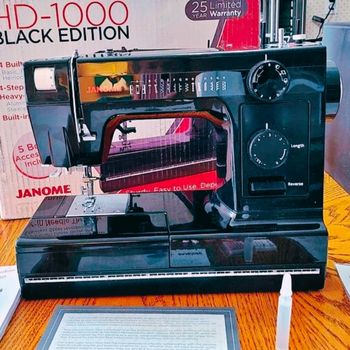
Features
- Type: Mechanic
- Speed: 840 stitches per minute
- Stitch Width: 5mm
- Stitch Length:4mm
- Weight:8lbs
- Warranty: 25 years limited
Have you ever noticed how off-putting it looks when you have a sewing machine in your beautiful room?
Yeah, it just doesn’t match the decor and homely ambiance. But with Janome industrial-grade sewing machine, you don’t have to worry about the looks. This powerful sewing machine has a sleek premium black color that blends into your room decor just like other furniture.
Besides, it’s constructed with industrial-grade materials; hence, it’s built to last. On top of that, you don’t need to be an expert to operate this Janome sewing machine. Any novice sewer can use it due to its user-friendliness. Thus, it’s one of the best sewing machines for sewing thick fabrics for beginners.
Moreover, you’ll have advanced accessories like four presser feet, needles, hardcover, bobbin, etc.
Now speaking of bobbin Janome HD1000 features a front-loading bobbin system incorporated with 14 stitches with 4 step buttonholes and stitch length and width adjustment capacity. Unlike the Janome HD3000, it’s much heavier yet easy to transport. Moreover, this tough sewing machine uses aluminum interior frames so that it remains steady during serious operation.
Furthermore, this sewing machine comes with a free-motion sewing caliber by drop feed with 3 piece feed dogs. Now let’s talk about the robust amp motor that undertakes a variety of fabrics and sewing tasks. Also, it has 1500 stitches per minute speed capacity. That’s not it, this sewing machine has a removable free arm for hemming small openings.
And since it already includes a blind hemming foot, you can achieve a blind hem with the right instructions. Personally, I like sewing cuffs with a blind hem and pant legs hemming.
Overall, whether you’re sewing thick fabrics like nylon webbings or making an Ellen Griswold costume, this machine got your back.
PROS:
CONS:
5. JUKI TL-2000Qi Sewing and Quilting Machine
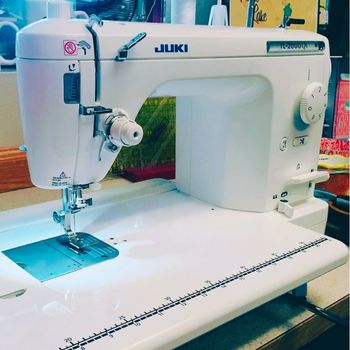
Features
- Type: Mechanical
- Speed: 1500 stitches per minute
- Built-in stitches: only straight stitches
- Stitch width: not specified
- Stitch length: 6mm
- Weight:4 lbs
- Warranty: 2/5 year
Here we have another creation from the Juki’s. It’s the tl 2000qi that comes with an extension table to hold a larger quilt. The fact that it effectively provides a wide working space makes it ideal for complicated sewing tasks.
Now the difference between Juki tl 2000 qi and the 2010qi is firstly the price. This one is way cheaper than the 2010qi; however, they weigh the same.
Besides, it distributes 1500 amp maximum load for heavy-duty quilting job and decor. Thus, this can also be a perfect sewing machine for nylon webbings.
Now at this rate, some sewing machines tend to vibrate or wobble, although this machine ensures providing low vibration sewing tasks.
Also, it has a needle threader that assists you in feeding the sewing thread through the eye of the needle. Here this sewing machine has one foot pedal operation facility for utmost manual speed control.
The benefit of one pedal works like a gas pedal of your vehicle. Meaning, the speed intensity increases every time you press it down.
The more force you exert downwards, the more speed it generates. To conclude, it’s one of the most budget-friendly sewing machines for beginner sewists who don’t want to compromise quality.
PROS:
CONS:
Best Sewing Machine for Thick Fabrics Buying Guide
How are you going to determine the ideal machine for your sewing tasks if you are a beginner?
Well, whether it’s a sewing machine for backpacking gear or a sewing machine for knit fabrics, you will definitely require some guidance. Thus, we have curated a brief buying guide where you will decipher the crucial facts to take into account while shopping for sewing machines.
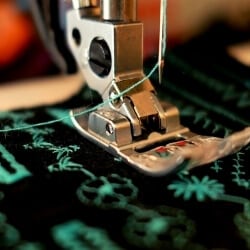
Sewing Machine For Thick Fabric
The Machine Type
There are basically 3 types of machines such as mechanical, electronic, and computerized sewing machines. All of them have individual specialties.
But in the recent era, computerized and electronic sewing machines are vastly used due to their faster and easier operation. For instance, when you are working on thick fabrics and want a wide range of stitch styles, an electronic sewing machine comes in handy.
However, mechanical sewing machines or regular sewing machines have their own attributes like adaptability, user-friendliness, inexpensive price, and last and most importantly, the suitability for beginner sewists. For example, while choosing the best sewing machine for marine vinyl as a beginner, you should go with a mechanical one.
Also, you have to fathom what kind of projects you are hoping to do in the near future.
If you are going to engage in utility stitches, only then having a good’ol mechanical sewing machine, i.e., regular sewing machine, like the Singer 4423 can do the job.
But if you are into heavy duty projects and the budget is flexible, then you can certainly go for computerized heavy duty machines, i.e., industrial sewing machine types. Now about the electronic ones, they are much faster in terms of operation and costs less than computerized ones. Thus, these are also considered as commercial grade sewing machine.
Sewing Type
You should determine the sewing type, such as heavy-duty denim, decors, leathers, etc. before you look out for a sewing machine. Also, you need to consider whether you’ll sewing sewing multiple layers of fabrics all the time or just once in a while.

Because the sewing machine is supposed to have all the anticipated sewing types and arrangements you desire to have. So, while looking for a sewing machine, ensure whether the machine is compatible with your requirements or not.
For instance, the singer 4423 is capable of sewing light fabrics and bulky materials too. on the flip hand, Janome and Brother mostly work best on thick materials like leather as well as small openings like hems and sleeves like the industrial sewing machines.
The Working Space
Thirdly you have to inspect the working space or throat size that also translates to the space between your sewing machine’s needle and the structure. If you are going to work on larger fabrics, then your throat plate should be wide and extended.
On the contrary, when you are invested in smaller sewing projects having a narrow throat plate will do just fine. Regarding this fact, the brother ST371HD sewing machine has a free arm and an extension table that can handle both wide and narrow quilts.
Sewing Style, Stitch Length, and Width
The more sewing style your sewing machine offers, the more versatile it becomes. Because when you have plenty of built-in sewing styles, you can work experiments on different sewing operations.
For example, the singer 4423 sewing machines have 23 built-in stitching styles in order to increase compatibility and idealness.
Now about the stitching length, it depends on your machine’s capability and the fabric you are working on. If the fabric requires a wider length and width in the stitches, your machine should have the capacity to tackle it.
Usually, sewing machines have a stitch length starting from 0 to 5mm. If you invest more, you can get more stitch length availability. Typically, fully manual sewing machines won’t offer you to set many stitch lengths. And they often don’t come with a walking foot either.
Tension Adjustment and Speed
Lastly, check out the tension adjustments which control the rigidity of the thread. This adjustment will allow you to decide whether to hold the fabric tight or loose. However, don’t ever hold it too tight in order to prevent puckered fabrics. Also your the grip shouldn’t be too loose that the stitches come off.
Here, with the speed, make sure you choose your unit from sewing machine brands with a suitable speed quotient according to your needs. If you want a faster operation, then choose a heavy-duty machine with a high stitching speed. For instance, the Singer provides 1100 stitches per minute. A slower sewing speed allows the beginners to have better control over the fabric.
How to Sew Thick Fabric With a Sewing Machine?
We believe you already chose your preferred sewing machine for crafting thick fabrics. But are you sure about the process of how to sew thick fabric with a sewing machine?
While we agree that typical sewing is not a big deal, we also admit that sewing through those thick layers of denim, vinyl, fake fur, or leather is no less than an intimidating chore.
Well, here we will show you one of the easiest and most effective ways possible. Have a look at these simple steps illustrated below!
Step 1: Trim the Seam Allowance
Before you start sewing with the machine, ensure checking the fabric layers whether it has an already sewn seam or not. If the seams are sewn already, then you need to scale down the overall bulk by pressing the seam open and minimizing the seam allowances.
Step 2: Pick the Right Needle
The needle is the main hero of your sewing project, which ensures a successful stitching session, especially when it comes to thick fabrics. That’s why you need to pick a tough needle that can handle extreme tension and can penetrate through thick layers. We suggest you using denim needles that come in 90 or 100 sizes.
Step 3: The Machine Setting
In order to stitch the thick fabrics together, you require a proper machine setting. Here, you need to increase the stitch length a little. However, if you are topstitching, then level up the stitch length at 3.5 mm up to 4.5mm.
Step 4: The Stitching
While many rely on the pedal to complete their stitching, we suggest you use the handwheel. Because it comes handier and does the job immaculately. Mostly if your subject fabric is relatively thicker and doesn’t have enough room, then using a handwheel works better than the pedal.
Step 5: Don’t Miss the Wedge
The myth of perfect sewing confides in the idealness of the presser foot. Otherwise, you will face a series of intricacies while sewing the first stitch. Now to ensure the rightness, you need to level the presser foot adequately.
All you need to do is fold a leftover fabric piece while keeping the thickness equivalent to the thickness of your sewing project. Once you are done, it’s time to put it under the presser foot and at the back until it’s leveled appropriately.
Step 6: Consider Using Special Feet
This step isn’t compulsory, but using some special feet can help you accomplish the task seamlessly.
You can either use a walking foot or a roller foot. The walking foot, almost a given in any heavy duty sewing machine for leather, facilitates an easy and swift movement to the top and bottom layer of the fabric. On the other hand, a roller foot helps to sew through sticky fabrics such as faux leather. Besides, it associates the feed dogs to push the fabric.
Frequently Asked Questions
Which sewing machine is best for thick fabrics?
We think naming only one will be a bit brutal as all of them works ideally.But in terms of thick fabrics the singer 4423 and JUKI 2010Q is the best.
What tension should I use for thick fabric?
For thick upholstery higher tension is required. Hence 4 to 5 mm tension will be all right.
Which is the best sewing machine for sew thick material and leather?
Singer heavy duty 4423 and brother ST371HD is the best sewing machine for thick material and leather.
Which type of sewing machine works the best for car upholstery?
We would recommend you get a walking foot sewing machine for upholstery if you’re planning on sewing auto upholstery exclusively. And for the slight tears here and there, you can opt for a fabric upholstery repair kit.
End Quote
We hope that the outlined review of the best sewing machine for thick fabrics was helpful in your concern. Here we personally recommend you our first pick if you are fishing for a faster and easy to use sewing machine.
On the other hand, we also suggest the brother sewing machine if you are looking for maximum stitching styles as it offers 37 built-in stitches.
Now, for holding larger quilts or fabrics, we put our faith in both of Juki’s creations, while for a powerful motor and buttonhole convenience, we believe in Janome. So, it’s time to choose one that fits all your requirement and looks like the most promising one.
REFERENCES

